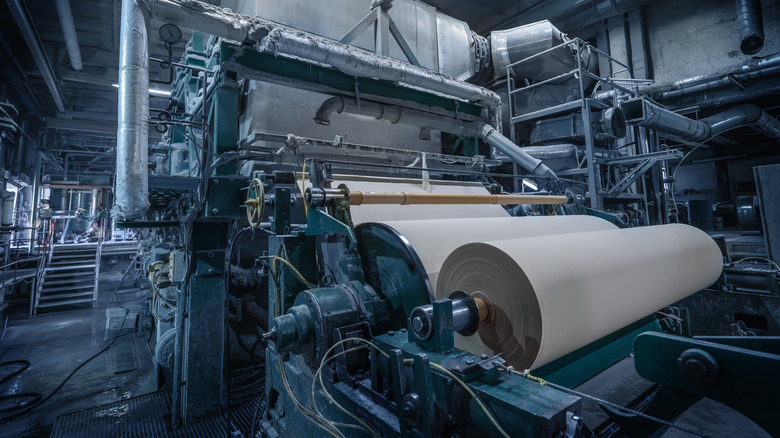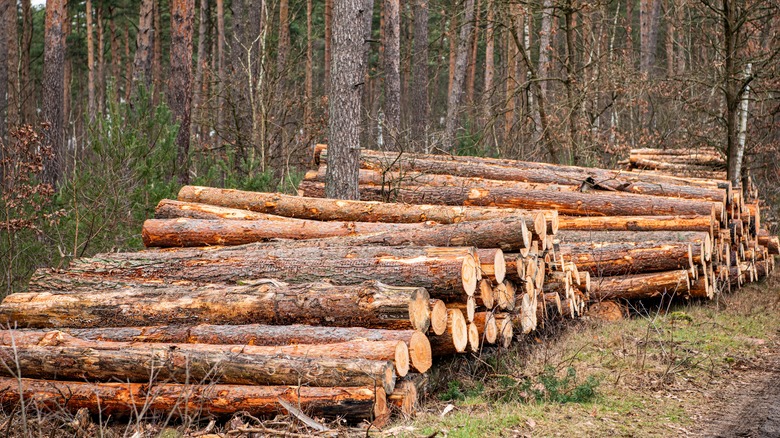How Are Trees Made Into Paper?
The history of paper, much like the history of humanity itself that it would go on to chronicle, was an evolutionary process. Writing systems evolved first on clay tablets before ancient Egyptians developed papyrus, a paperlike material made by layering fibers from papyrus reeds that grow along the Nile and pounding them into flat sheets. It wasn't until 200 B.C. that the first evidence of true paper appeared, being made from the pulp of various plants including bamboo, hemp, and the bark of mulberry trees. The latter is particularly significant, as it would set the precedent for today's papermaking industry, in which trees are the material of choice for over 90% of all paper.
The ancient Chinese also set the precedent for today's paper-manufacturing process. Those early papermakers took discarded plant material and soaked it in water until it was soft enough to be broken down. They used a heavy mallet to beat the soaked plant fibers into a pulp, which they then pressed into sheets and dried. In addition to tree bark, bamboo, and hemp, many other plants were also used for papermaking, with rattan being particularly popular in those early days. When papermaking reached Europe, old cloth became the preferred material, which remained the case even up to the founding of the United States. It was only in the mid-1800s that trees became the sole standard material for the majority of paper, a transition that was driven by the invention of the modern papermaking process.
The modern papermaking process
Today, most paper is made using the same basic steps that defined the original Chinese papermaking process. However, modern technologies have added a few key elements, including several chemical reactions.
The journey from tree to paper begins in the forest where trees are felled and taken to lumber mills. There, their bark is stripped away, and the wood is hacked into chips. These wood chips contain two main components: fibers, which are used to make paper, and lignin, the liquid substance that binds fibers in wood, but which needs to be removed for the purpose of papermaking. This is usually achieved via a method called the kraft process, which entails cooking the wood chips in a solution of water, sodium hydroxide, and sodium sulfate to separate the lignin from the fibers. This lignin runoff is actually used to power the boiler system used for the kraft process.
Chemical reactions like the kraft process are the most common way to make paper pulp, but it can also be made by physically grinding wood into a pulp. This creates a less-pure paper that still has lignin in it, and is usually used for flimsier products like newspapers. However the paper pulp is obtained, the final step of the manufacturing process entails pressing it into a thin sheet and drying it to remove every last trace of moisture. This leaves you with huge sheets of paper ready to be cut down to size for any use.
The environmental impacts of papermaking
As you might assume, papermaking takes a significant toll on the environment. A wide variety of trees are used to make paper, but pine trees are the most common. A single 60-foot-tall pine tree can weigh over 1,500 pounds, but only about half of it can be used to make paper, the rest is lignin (not to mention knots, rot, and all the various blemishes that can make some wood unusable for paper). All told, paper manufacturing has made a huge dent in the world's forests, which has in turn diminished the territory of untold species as well as exacerbated greenhouse gas emissions, since trees absorb and store carbon dioxide, a primary driver of the climate change crisis.
You might expect that the rise of the internet would lead to a decrease in paper use, but that hasn't actually been the case. The manufacture of printer paper has been on the decline, but that only accounts for a fraction of the paper industry. Overall paper manufacturing, which includes products like toilet paper, grows ever greater along with the human population.
Fortunately, paper is highly recyclable. The whole papermaking process can be done using chopped up bits of paper rather than wood chips, which can survive five to seven cycles before the wood fibers become too shortened and stiff to be used any further. The paper recycling rate in the United States has exceeded 60% every year since 2009, according to Statista, a positive mark that will hopefully continue to grow.


